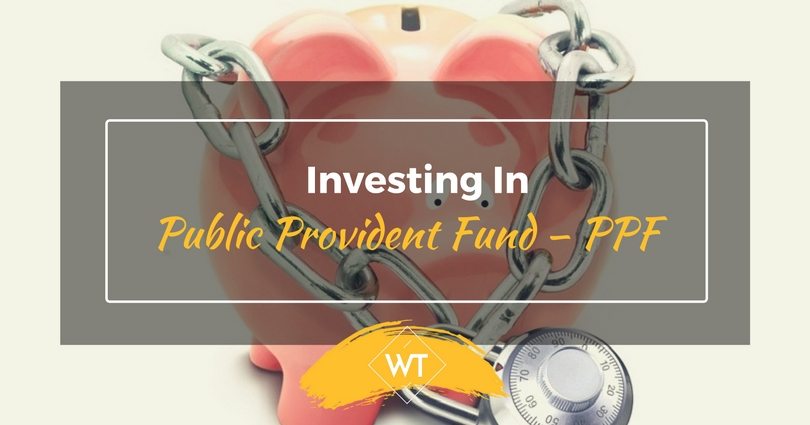Investing in Public Provident Fund – PPF

Public provident fund (PPF) is the blue-eyed scheme of all the investment schemes available in India. And why do I say that? Read on to find out more.
I have seen people struggling to find schemes to invest for the 80C benefit. Most often than not 80C benefit is not utilized other than the PF deducted from one’s salary. Here is one scheme that is easy to understand, easy to invest, flexible and reliable. Now you know why I call it the blue-eyed scheme!
PPF is governed by the Public Provident Fund Act, 1968. It is a scheme under the purview of the Government of India. So, you know that your money is in the safest of all possible hands! Interests earned on PPF account are compounded annually @ the rate prevailing for that financial year.
Investing in PPF
You can open a PPF account in any nearest Post Office or any branch of SBI including other nationalized banks specified by SBI. The scheme specifies a minimum of Rs. 500 and a maximum of Rs. 70,000 in any year. It is interesting to note that though the maximum investment amount for availing benefit under section 80C is Rs. 100,000, the maximum investment in PPF is still plugged at Rs. 70,000 as specified in the PPF act.
Flexibility
If there was ever a scheme more flexible than the PPF, I am yet to find one! PPF is flexible by:
Amount
You can choose to invest any amount between Rs. 500 to Rs. 70,000 in each year. Unlike other schemes where you commit to an amount at the beginning of the scheme, you get to decide the flexibility of your investment every year.
Date
The date of investment is flexible meaning you can invest at any time during the year at your convenience. You can choose to invest on 31st March for one year and on 1st April for the next year.
Installments
Installment options are also available for investment in PPF. You can invest in multiple installments as long as you make sure you don’t invest more than 12 times in a year.
Mode of payment
You can make the investment by cash, cheque, demand draft or pay order in favor of the Officer in the branch where investment is made.
Rigidity
The only rigidity in PPF investment is its tenure of a minimum of 15 years. See “Loans and withdrawals” section for cashing options within 15 years. See “Maturity” section for extension options.
Who can Invest
Any resident individual, irrespective of investments into GPF or EPF, can invest in PPF in his name or in the name of their spouse or minor child. A minor can also invest through a guardian (any parent, where parents are alive). NRI’s cannot invest in this scheme but can continue to hold the scheme during the tenure. Note that a PPF account can never be a joint account. Nomination facility is however, available. The following people can invest:
- Resident Individuals
- Minors through parents / guardians where parents are not alive
- Any person acting on behalf of a Hindu Undivided Family
- Residents who have started investing in PPF can continue after they become Non-Resident Individuals
Caution: At any given time you can hold only one PPF account in your name. If you hold more than one, and it is detected, the account will be closed and all the interest will be forfeited. You will, however, be refunded the principle amount.
Interest on PPF
Interest on PPF is calculated by calendar month on the lowest balance between 5th to 31st of that month @ the specified interest rate. This interest is reflected at the end of the year and is compounded annually. Meaning you earn interest on the principal amount and also on the interest earned on that scheme. The rate of interest varies as per the government notification. The current rate of interest for the financial year 2011-12 is 8%.
The below table ind`icates the maturity amount for investments of Rs. 500/- @ 8%.
| Year | Opening Balance | Investment amount | Interest | Closing Balance |
| 1 | 0 | 500 | 40 | 540 |
| 2 | 540 | 500 | 83 | 1,123 |
| 3 | 1,123 | 500 | 130 | 1,753 |
| 4 | 1,753 | 500 | 180 | 2,433 |
| 5 | 2,433 | 500 | 235 | 3,168 |
| 6 | 3,168 | 500 | 293 | 3,961 |
| 7 | 3,961 | 500 | 357 | 4,818 |
| 8 | 4,818 | 500 | 425 | 5,744 |
| 9 | 5,744 | 500 | 500 | 6,743 |
| 10 | 6,743 | 500 | 579 | 7,823 |
| 11 | 7,823 | 500 | 666 | 8,989 |
| 12 | 8,989 | 500 | 759 | 10,248 |
| 13 | 10,248 | 500 | 860 | 11,607 |
| 14 | 11,607 | 500 | 969 | 13,076 |
| 15 | 13,076 | 500 | 1,086 | 14,662 |
| Total | 7,500 | 7,162 |
The below table indicates the maturity amount for investments of Rs. 70,000/- @ 8%.
| Year | Opening Balance | Investment amount | Interest | Closing Balance |
| 1 | 0 | 70,000 | 5,600 | 75,600 |
| 2 | 75,600 | 70,000 | 11,648 | 157,248 |
| 3 | 157,248 | 70,000 | 18,180 | 245,428 |
| 4 | 245,428 | 70,000 | 25,234 | 340,662 |
| 5 | 340,662 | 70,000 | 32,853 | 443,515 |
| 6 | 443,515 | 70,000 | 41,081 | 554,596 |
| 7 | 554,596 | 70,000 | 49,968 | 674,564 |
| 8 | 674,564 | 70,000 | 59,565 | 804,129 |
| 9 | 804,129 | 70,000 | 69,930 | 944,059 |
| 10 | 944,059 | 70,000 | 81,125 | 1,095,184 |
| 11 | 1,095,184 | 70,000 | 93,215 | 1,258,399 |
| 12 | 1,258,399 | 70,000 | 106,272 | 1,434,671 |
| 13 | 1,434,671 | 70,000 | 120,374 | 1,625,044 |
| 14 | 1,625,044 | 70,000 | 135,604 | 1,830,648 |
| 15 | 1,830,648 | 70,000 | 152,052 | 2,052,700 |
| Total | 1,050,000 | 1,002,700 |
Note: The above table is illustrative and has a number of assumptions. The numbers above will change as per the date of investment, amount of investment and the prevailing rate of interest.
So, the maturity amount for investing Rs. 500 every year would be 14,662 and for investing Rs. 70,000 every year would be Rs. 20,52,700.
Previously, interest on PPF was totally tax free. However, all interests earned after 1st April 2011 will be subjected to tax at the time of withdrawal. Meaning, balance in your PPF account on 31 March 2011 will be totally tax free, whereas any interest earned after that will be subjected to tax as and when you withdraw the amounts.
Tip: Interest is calculated by calendar month on the lowest balance between 5th and last day of the month. Meaning if you invest on say 20th March, you will not receive interest on that amount for that month. Therefore, be sure to make all your investments before the 5th of the month.
Defaulters
What happens if you forget to make an investment in any particular year? Simple, you pay Rs. 50 as a fee (not as an investment) per year of default along with the investment amount of Rs. 500 per year. And your account is active again!
Loans and Withdrawals
The only catch with PPF is its long tenure. 15 years is a long time and it is really difficult to see the money sitting there to be left untouched. To facilitate use of this money, there are two options:
Loan against PPF
You can avail of a loan against the PPF account between Year 2 and Year 5 upto 25% of the balance available in your account in the second preceeding year in which loan is applied. Meaning, if you have applied for a loan in Year 4, you will get an amount of 25% of the Balance as at the end of Year 2. This loan has to be repayed into the account within 36 months at your convenience. Interest is charged @ 1% per annum on this amount.
Withdrawal of PPF
Partial withdrawal option is available against your PPF amount from Year 7. The amount is limited of 50% of lower of the balance at the end of the preceeding year or balance at the end of preceeding fourth year (minus amounts already availed as loans). You can make withdrawals every year. Full withdrawal is available only at the end of 15 years.
Tip: Once you have made investments in the first 7 years, you can withdraw the amount required for making further investments and re-invest the same into the scheme. That way, you can avail the benefit under section 80C and not make additional investments. However, interest earned after 1st April 2011 will be taxable on withdrawal.
Maturity
Options available on maturity (after 15 years):
- Close the account and withdraw the amount.
- Withdraw as per your convenience once every year. And meanwhile, you will continue to earn interest on the balance amount but cannot invest additional amounts.
- You can also choose to continue the scheme for a further period of 5 years during which you will continue to receive interest and can also make further deposit.
We all work hard for our money, but here is the blue-eyed scheme which will make your money work harder for you! Happy investing!









Leave a Reply